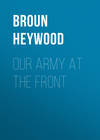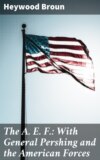Czytaj książkę: «Our Army at the Front», strona 11
CHAPTER XXIII
ST. MIHIEL
HISTORIANS and military experts are fond of taking one particular battle or campaign, and saying: "This was decisive." It enables one to simplify history, to be sure, but often any such process is more simple than truthful. After all, every battle is to some degree decisive, and the great actions of the war are so closely connected with smaller ones that it is difficult to separate them. It is the fashion now to speak of the second battle of the Marne as the deciding factor in the war. Indeed, there is one school of strategists which goes back to the first Marne, and speaks as if nothing which happened after that really mattered.
In this spirit, it is true, that the great tide in the allied fortunes which began at Château-Thierry and swept higher and higher until the Germans had been smashed in the second battle of the Marne, did put a new complexion on the war. The battle definitely robbed the German offensive of its threat. Paris was saved, in all human probability, from ever coming into danger again during the course of the war. Nevertheless, it is far-fetched to take the attitude that the war had already been won early in August. It was evident by this time that the German Army had suffered a great defeat. Perhaps a great disaster would be better. And yet other armies have suffered great disasters and grown again to power and success. The plight of the Germans was certainly little worse than that of the Italians after the German offensive, and yet everybody knows that the Italian Army came back from that defeat to final victory.
Morale is subject to miracles, and soldiers can be born again. There might have been combinations of circumstances which would have permitted the German Army to recover from its fearful defeat and find again its old arrogance and confidence. Only it had no rest. It is fitting, then, that the men of all the armies who completed the downfall of the Germans in the marvellous campaigns at the close of the year 1918 should have due credit. Their work was also decisive. No one can tell what would have happened to the German Army if it had not been subjected to the steady pounding of the allied armies.
No attempt will be made here to estimate the relative importance of the work done by the various allied armies in the closing campaigns of the war. This is an interesting, although somewhat ungrateful, task for military experts. In this account we are dealing simply with the fortunes of the American Army. It might not be amiss to suggest that the final victories of the war were won by team-play, and that in such combinations of effort the praise should go to all, just as the labor does.
There need be no controversy, however, about the battle of St. Mihiel. This was an American action. It was under the command of General Pershing himself, and his forces were made up almost entirely of Americans. The French acted in an advisory capacity, and we were dependent, in part, upon them for certain material. General Pershing in his official report says: "The French were generous in giving us assistance in corps and army artillery, with its personnel." We were also under obligation to the French for tanks, but here they were not able to assist us so liberally, because they had barely enough tanks for their own use. One of the surprising features of the St. Mihiel victory is that it was achieved with comparatively slight tank preparation.
St. Mihiel represented the biggest staff problem attempted by the American Army up to that time. It was, of course, a battle which dwarfed any previous action in the military history of America. Compared to the battle of St. Mihiel, the whole Spanish-American War was a mere patrol encounter, and Gettysburg itself a minor engagement. With the force at his command, and the weapons, General Pershing could have annihilated the army of either Grant or Lee in half an hour. Some idea of the magnitude of the battle may be gathered from the report of General Pershing: that he had under his command approximately 600,000 troops, or four times the peace standing of the entire American military establishment before the war.
It is difficult enough to move an army of that size, with its supplies and its guns, under any conditions, but the plan for the St. Mihiel offensive called for a surprise attack, and it was necessary to make all the troop movements at night. In spite of the vaunted efficiency of the German intelligence, there seems to be evidence that their high command had little inkling of the magnitude of the blow impending or the date on which it would fall. The St. Mihiel salient had been so long a fixture in the geography of the battle-lines that no change was expected.
In preparation for the offensive the First Army was organized on August 10, under the personal command of General Pershing. Following this move the Americans took over part of the line. This became a permanent American sector. Pershing took command of the sector on August 30. At that time the sector under his command began at Port sur Seille, and extended through a point opposite St. Mihiel, then twisting north to a point opposite Verdun. The preparations for the offensive included, in addition to guns, men, and tanks, the greatest concentration which the American Army had ever known in transport, ambulances, and aircraft. Most of the planes in action were of French make, and some were flown by the French, but there were a few of our manufacture, for on August 7 an American squadron, completely equipped by American production, made its appearance at the front.
The preparations for the offensive were minute as well as extensive. It is, perhaps, worth noting as a sample of the thoroughness with which the American Army went about the job that no less than 100,000 maps were issued which showed the character of the terrain around St. Mihiel, with all the natural and artificial defenses carefully noted, and some estimate of the strength in which the enemy was likely to be found at each point. The army had 6,000 telephone instruments, and at least 5,000 miles of wire, so there was no difficulty in keeping in touch with what the men were doing at every point. The attack began at 1 A.M. on September 12. The American artillery had been crowded into the sector to such an extent that the German artillery was completely dominated. The bombardment lasted for four hours, and then the troops went forward, preceded by a few tanks, but there were points where infantry went forward without the aid of these auxiliaries. It was misty when the seven divisions in the front line sprang out of their trenches, and this helped to keep losses down. Indeed, throughout the battle the resistance proved much less determined than had been anticipated.
Although the bombardment had been short, most of the wire had been cut. There remained a few jobs, however, for the wire-cutters, and for other soldiers armed with torpedoes. With one method or the other our men smashed what was left of the wire guarding the enemy first-line trenches. And then the waves came on and over. There was little resistance in the first line, for the Germans in these positions were pretty well demoralized by the terrific artillery pounding which they had received and the sight of thousands upon thousands of Americans rushing upon them from out of the fog. For the most part they surrendered without resistance. As the advance progressed resistance became stiffer at some points, but the attackers kept pretty generally up to schedule, or ahead of it. Thiaucourt was taken by the First Corps. The Fourth Corps fought its way through Nonsard. The Second Colonial Corps was not asked to make a very great advance, but it had the most difficult terrain over which to work. It had won all its objects early in the day. A difficult task was also set for the Fifth Corps, which took three ridges and then immediately had to repulse a counter-attack. St. Mihiel fell early in the day. And in an incredibly short period a salient which had been in the enemy hands for almost four years was pinched out of existence.
Everybody was delighted to find that in one respect the American preparations had been too extensive. No less than thirty-five hospital-trains had been assembled back of the attacking forces, and there were beds for 16,000 men in the advanced areas, with 55,000 a little farther back. As a matter of fact, less than one-tenth of these facilities proved necessary, for the American casualties were only 7,000, and many of these were slight. The German General Staff always maintained that it had anticipated the attack and that its men were under orders to retire, as the salient was of no strategic importance. The last assertion may be true, but there seems to be little to support the rest, for the total of prisoners was 16,000, with 443 guns. The quantity of material captured was enormous. In a single depot there were found 4,000 shells for 77's and 350,000 rounds of rifle cartridges. Among the other assorted booty were 200 machine-guns, 42 trench-mortars, 30 box-cars, 4 locomotives, 30,000 hand-grenades, 13 trucks, and 40 wagons. The number of German helmets which fell to the doughboys was naturally countless.
The attack was so completely successful and ran so closely to schedule that there were few surprises. A little group of newspaper men, however, were frank to admit that they had encountered one. Following closely upon the heels of the attacking troops, they came to a village which was being heavily shelled by the Germans. Accordingly, the newspaper men took refuge in a dugout until such time as the opportunity for observation should be more favorable. Coming from the other direction, a group of German prisoners entered the same village. They had surrendered to one of the waves of onrushing Americans, but everybody was too busy to conduct them personally to the rear. They had merely been instructed to keep marching until they encountered some American officers or doughboys who were not otherwise engaged, and then surrender themselves. When the shells fell fast about them the Germans darted for the dugout in which the newspaper men had previously taken refuge. The correspondents were astounded and disturbed when sixteen field-gray soldiers came tumbling in upon them. They could only imagine that at some point the Germans had struck back and that the counter-attack had broken through. And the correspondents admit that without a moment's hesitation they gave one look at the Germans and then raised their weaponless hands and cried "Kamerad." The perplexing feature of the situation was that the Germans did exactly the same thing, and a complete deadlock ensued until a squad of doughboys happened along that way and took the Germans in charge.
Both sides in the battle were willing to admit that their foemen had fought with courage. While it is true that the first waves of the American Army had an easy time, there was stiff but ineffectual resistance by German machine-gunners later in the day. Many of these men served their guns without offering surrender, and had to be bombed or bayoneted. In a document by a German intelligence officer, which fell into American hands much later in the war, a very frank tribute was paid to the extraordinary courage of the Americans. The German officer said that they seemed to be absolutely without fear on the offensive, and must be reckoned with as shock troops, although they sometimes fought greenly. He reported, however, that American leadership was less impressive, and stated that the American Army might have gone much farther if it had been more quick to take advantage of its early success. But this would seem to be a mere effort to whistle up courage in the German General Staff, for a consideration of the territory which fell into American hands as a result of the attack shows some measure of its success. This comprised 152 square miles which was recovered from the Germans. And in this liberated district were 72 villages.
And yet the importance of the battle can hardly be measured in territory regained, and much less in booty or in guns. "This signal success of the American Army in its first offensive was of prime importance," wrote General Pershing in his report to Secretary Baker. "The Allies found that they had a formidable army to aid them, and the enemy learned finally that he had one to reckon with." Moreover, the pinching out of the St. Mihiel salient put the American Army in a position to threaten Metz. This threat was one of the factors which caused the enemy to realize a few months later that further resistance could not hope to check the allied armies for any considerable time.
The divisions employed at St. Mihiel comprised many of our best units. Among the divisions engaged were the Eighty-second, the Ninetieth, the Fifth, and the Second, which made up the First Corps, under Major-General Hunter Liggett. In the Third Corps were the Eighty-ninth, the Forty-second, and the First Divisions, under Major-General Joseph T. Dickman. The Fifth Corps, under Major-General George H. Cameron, had the Twenty-sixth Division and a French division. In reserve were the Seventy-eighth, Third, Thirty-fifth, and Ninety-first Divisions. The Eighteenth and Thirty-third were also available.
CHAPTER XXIV
MEUSE-ARGONNE BEGINS
HAVING successfully accomplished one piece of work, the American Army received as its reward another piece of work. The reward consisted in the fact that the second task assigned to Pershing's men was, perhaps, the hardest possible at any point in the line. Since 1915 the Argonne Forest had been a rest area for the German Army. Everything had been done to make the position impregnable, and so it was in theory. But the Americans broke that theory and took the forest. So confident were the Germans of their tenancy that they had built all sorts of palatial underground dwellings. Barring light, there was no modern convenience which these dugouts (although that is no fit name) did not possess. Some had running water. All the most pretentious ones had feather-beds, and the big underground rooms were gay with pictures and furniture stolen from the French. The defenses of the positions in the forest included miles and miles of barbed wire, sometimes hidden in the underbrush, and again carried around tree-trunks higher than a man could reach. There were high concrete walls to stop the progress of tanks and deep-pit traps into which they might fall. And machine guns were everywhere.
The Meuse-Argonne campaign, which falls into three phases, reads far differently than the taking of St. Mihiel. Except in its early stages this was no grand running, flawless offensive without a hitch worth mentioning. In the nature of things it could not be so. The Argonne was less susceptible to the laws of military strategy. Warfare in these woods became a struggle between small detached units. Much of the fighting took place in the dark and practically all of it in the rain. The American victory was a triumph of the bomb and the rifle, and perhaps the wire-cutter should be added, over the machine-gun. In many encounters the opposing units fired at each other from short ranges, and directed their fire solely by the flashes of the other fellow's machine-gun. War in the Argonne Forest was a cat-and-dog fight, and Germany was destined to play the cat's usual rôle, though she clawed her hardest.
And yet though many of the phases of the Meuse-Argonne were primitive and elemental in their nature, sound strategy lay behind the campaign. General Pershing in his vivid report explains not only the necessity for the campaign but the objects which he sought and gained. St. Mihiel shook the confidence of the Germans, but neither that success nor those scored by other allied armies was sufficient to batter the Germans into defeat.
"The German Army," wrote General Pershing, "had as yet shown no demoralization, and while the mass of its troops had suffered in morale, its first-class divisions, and notably its machine-gun defense, were exhibiting remarkable tactical efficiency as well as courage. The German General Staff was fully aware of the consequences of a success on the Meuse-Argonne line. Certain that he would do everything in his power to oppose us, the action was planned with as much secrecy as possible, and was undertaken with the determination to use all our divisions in forcing decision. We expected to draw the best German divisions to our front and to consume them while the enemy was held under grave apprehension lest our attack should break his line, which it was our firm purpose to do."
"Our right flank," wrote General Pershing in describing his position at the beginning of the battle, "was protected by the Meuse, while our left embraced the Argonne Forest, whose ravines, hills, and elaborate defense screened by dense thickets, had been generally considered impregnable. Our order of battle from right to left was: the Third Corps from the Meuse to Malancourt, with the Thirty-third, Eightieth, and Fourth Divisions in line, and the Third Division as corps reserve; the Fifth Corps from Malancourt to Vauquois, with Seventy-ninth, Eighty-seventh, and Ninety-first Divisions in line, and the Thirty-second in corps reserve; and the First Corps, from Vauquois to Vienne Le Château, with Thirty-fifth, Twenty-eighth, and Seventy-seventh Divisions in line, and the Ninety-second in corps reserve. The army reserve consisted of the First, Twenty-ninth, and Eighty-second Divisions."
The American Army had no extended vacation after the victory at St. Mihiel. That action had hardly been completed when some of the artillery left its positions and departed for the Meuse-Argonne front. St. Mihiel began on September 12. Just two weeks later the first attack in the long-protracted Meuse-Argonne campaign began. The first portion of this offensive was by far the easiest. It was difficult, to be sure, but the terrific hardships were still to come. One factor which mitigated the task of the troops engaged in the first attack was that again the Germans seemed to have been taken by surprise. The Americans moved very fast over difficult terrain. This was country which had already been sorely disputed, and shell-holes were everywhere. In the places where there were no shell-holes there was barbed wire.
As the attack progressed the German resistance increased. Artillery was moved forward and machine-guns seemed to spring up overnight in that much ploughed and harrowed land. Yet after three days' fighting the Americans had penetrated a distance of from three to seven miles into the enemy's positions, in spite of the large numbers of reserves which were thrown in to check them. Even a German communiqué writer would hardly have the face to maintain that the territory captured by the Americans was of no strategic importance. Every mile that Pershing's men went forward brought them that much nearer to Sedan, and on Sedan rested the whole fate of the German lines in France. But Sedan was still many a weary mile away. The territorial gains in the onward rush of the first three days included the villages of Montfaucon, Exermont, Gercourt, Cuisy, Septsarges, Malancourt, Ivoiry (known to the doughboys, of course, as Solid Ivory), Epinonville, Charpentry, and Very. Ten thousand prisoners were taken.
In spite of this great success it was not possible for the Americans to drive straight forward. The country over which the action was fought was so bad that several days were needed to build new roads up to the positions which had been won. Even with the best efforts in the world, the moving of supplies was a prodigious job. The mud was almost as great a foe as the German guns. In the necessary lull the Germans, of course, rushed new troops into the sector to combat the American advance. Naturally, the lull was not complete. There was constant raiding by Americans to identify units opposed to them, and here and there in small local attacks strategic points were taken which would be of advantage in the big push to come. From prisoners the Americans learned that among the divisions opposite them were many of the crack units of the German Army. America was also represented by its best organizations, but under the constant losses incurred in attacks against strongly intrenched positions units dwindled, and replacements were poured in. Under the circumstances it was necessary to send many soldiers to the front who had been in training but a short while. These were mixed in, however, with veterans, and it should be said to the credit of these green men that in practically every case they upheld the reputation of the units to which they were sent. They were quick to feel themselves as sharers in the reputation of their new-found organizations.
There was no element of surprise to help the American Army when the attack began again in full force on October 4. Where progress before had been measured in miles, now it was counted in yards. Possibly it was even a matter of feet at some points in the line. Yet always the movement was forward. Weight of numbers and dogged courage proved that machine-gun nests of the strongest sort were vulnerable. The Germans counter-attacked constantly, but such tactics were actually welcomed by the Americans as they brought the Germans into the open and gave our riflemen and machine-gunners something at which to shoot. The difficulties with which the Americans had to contend may be judged by the fact that, according to an official report, the Germans had machine-guns at intervals of every yard all along their line.
The Argonne fighting produced many actions more important than the rescue of the Lost Battalion, but hardly any as dramatic. The incident could have happened only in the Argonne, where communication with co-operating units was always difficult, and sometimes impossible. Major Whittlesey's battalion, in making an attack through the forest, gained their objectives, only to find that they were out of touch with the American and French units with which they were co-operating. It is not true, as sometimes reported, that Whittlesey pushed ahead beyond the objectives which had been set for him. Nevertheless, he was so far away from help as to make his chances of rescue small. German machine-guns were behind him. His men were raked by fire from all sides. Yet their position was a strong one and they hung on. Soon their rations were gone. For more than twenty-four hours even their position was unknown to the American Army. Eventually they were located by aeroplanes and an attempt was made to supply them with food and ammunition. Even yet rescue seemed a long chance. The Germans thought the battalion was at their mercy and sent a messenger asking Whittlesey to surrender. He refused, and the "Go to Hell" which has been put into his mouth as a fitting expression for the occasion will probably go down in American history in spite of the fact that Whittlesey has done his best to convince people that he never said it. Several attacks were made in an effort to rescue the Americans but without success until a force under Lieutenant-Colonel Gene Houghton broke through and brought the exhausted men back to safety.
The last strongly fortified line of the Germans was the Kriemhilde, and the second phase of the Meuse-Argonne offensive had not been in progress long before our men were astride the line at many points. But there was still much desperate fighting to do before the Germans were completely driven from their scientifically perfect positions. The honor of actually breaching the line fell to the Fifth Corps, which entered the line on October 14 and drove the Germans out after some fearful close fighting. In the meantime the continual pressure of the American forces was beginning to tell. Châtel-Chehery fell to the First Corps on October 7. On the 9th the Fifth Corps took Fleville, and the Third Corps, after some desperate fighting, worked its way through Brieulles and Cunel. By October 10 the Argonne Forest was practically clear of the enemy.
One of the important factors in the Argonne campaign was aviation. Aerial activity was great on both sides, since in no other campaign was observation so difficult or so important. Both sides did a great deal of day bombing, and during one such American foray the greatest battle of the air took place. The American expedition consisted of thirty-four machines. It was attacked by thirty-six Fokkers. Although the German machines are faster, the American squadron managed to hold its formation. Seven Fokker machines were brought down in the battle and five American.
All in all, the Meuse-Argonne campaign was one of the most remarkable in the history of the war. Its second phase in particular is sure to be a bone of contention for military experts. General Pershing himself declared very frankly in his report to Secretary Baker that he had purposely abandoned traditional military tactics in the campaign. "The enemy," he wrote, "had taken every advantage of the terrain, which especially favored the defense, by a prodigal use of machine-guns manned by highly trained veterans, and by using his artillery at short ranges. In the face of such strong frontal positions we should have been unable to accomplish any progress according to previously accepted standards, but I had every confidence in our aggressive tactics and the courage of our troops."
Such strategists as oppose the theory of the Meuse-Argonne campaign will undoubtedly assert that American losses were high. In rebuttal defenders of the plan of the campaign will say that the losses were very light considering the nature of the fighting, and that the campaign shortened the duration of the war appreciably by putting the Germans into a position where they were compelled either to surrender or be overwhelmed. But whatever decision may be reached by the experts, there is no necessity of calling for testimony as to the part the American soldier played in this campaign. It seems fair to say that he has never shown more dogged courage or resourcefulness than in the fighting in the forest.
















